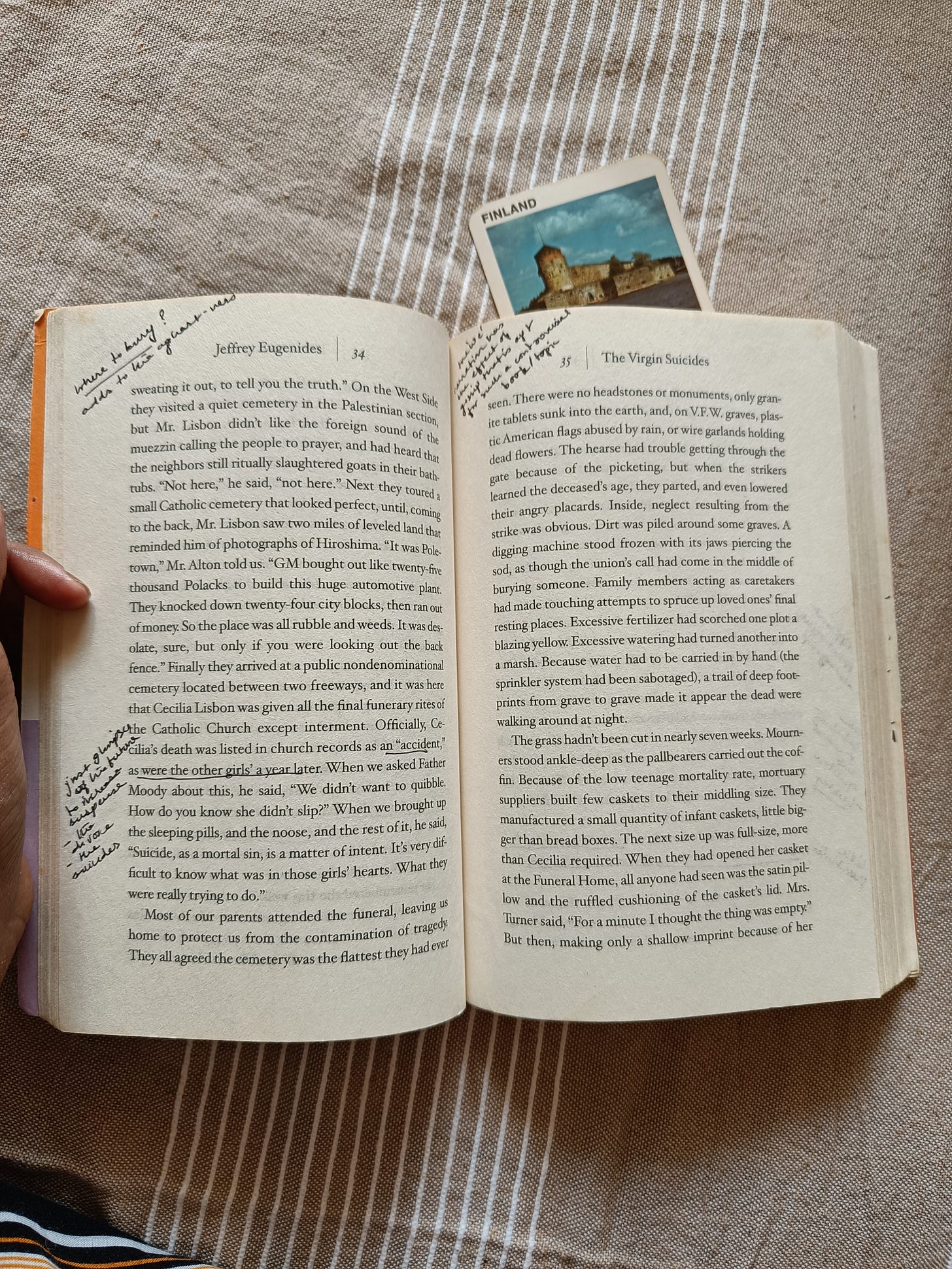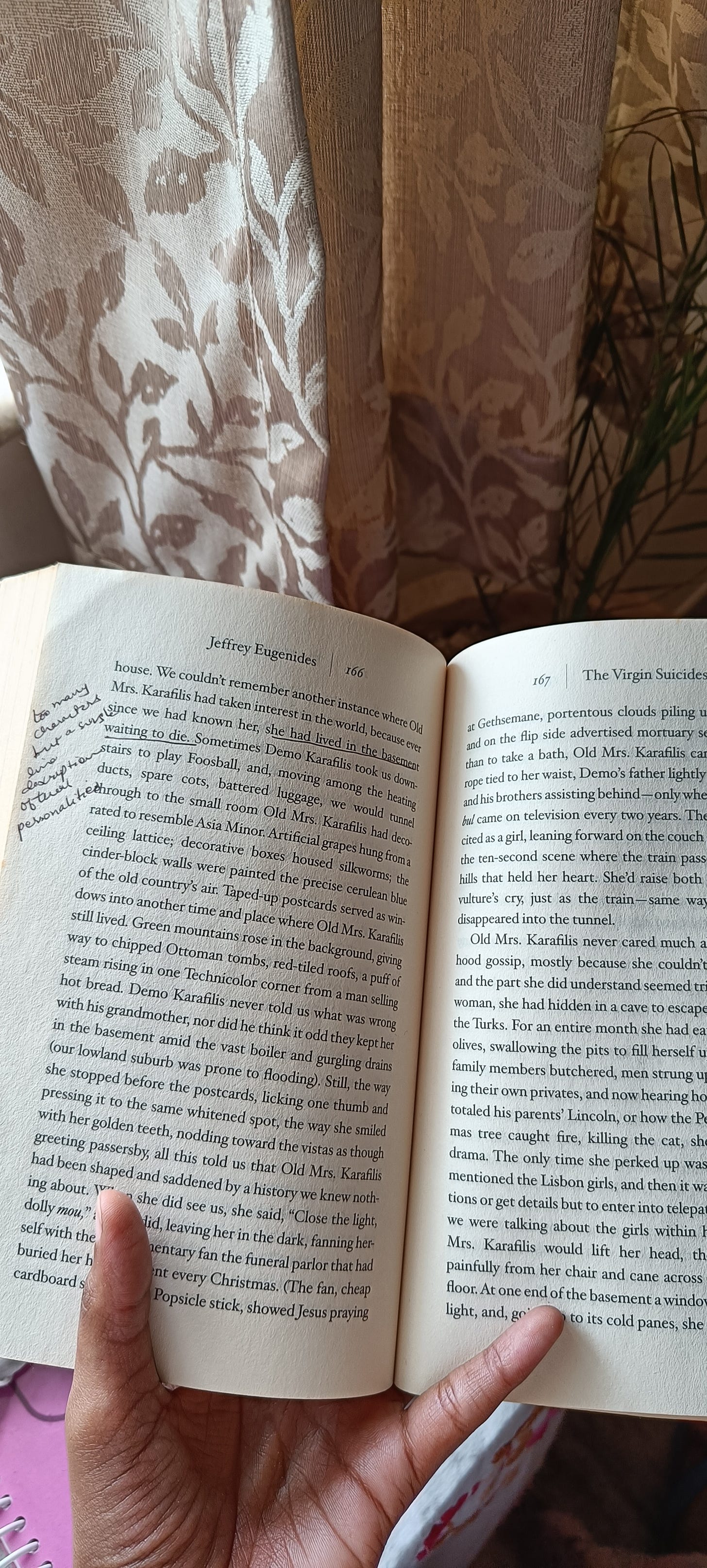Craft lessons from Eugenides
CRAFT TALK: Reading like a writer...And updates
A few weeks back, I found myself re-reading The Virgin Suicides by Jeffrey Eugenides, only this time, I made notes in the margins (see photo gallery at the end). The reason I keep returning to this book is because I find it simply fascinating, craft-wise and otherwise. It’s rich, textured, tells an interesting story, and tells it brilliantly! So, I decided to do a poll on Instagram and ask if I should do a ‘Craft lessons from Eugenides’ letter. 100% voted yes (of course, not everyone voted), so as promised, here it is!
Since the book is about a delicate subject (you can guess from its title), to make this letter easily readable and accessible for everyone, I will try my best to not go into the details of what happens in the story and just hand you those delicious craft nuggets Eugenides offers. Nevertheless, there might be content in this letter, that some might find disturbing, so please use your discretion:) Of course, if you’ve read the book, you will understand these points much better.
1) Correct point-of-view
Every story needs a point-of-view - the perspective from which the story it is told. Copy-pasting the most common POV (third person omniscient) into every story is a tad bit lazy. Every story is different and has different requirements. In The Virgin Suicides, Eugenides uses the third person collective POV. The story of the five Lisbon sisters and their suicides, is told from the perspective of a group of boys in their neighborhood - the boys they go to school with, who can look at them from their windows and balconies. Eugenides uses ‘we’ and ‘us’ instead of ‘them’ or ‘you.’ If you’ve never read and written in the third person collective POV, you should really check it out. It’s my personal favorite POV. In fact, I wrote a short story, Maybe a Butterfly Will Sit on Us in this POV. You can read it here.
Now, you might ask, why did Eugenides pick the third person POV, really? because its different and might seem interesting? No. I mentioned earlier that every story has different requirements which the writer needs to meet. If you’ve read the book, you know small talk, gossip and scandal are central to its narrative. The boys tell the story of the Lisbon sisters, who have all committed suicide. The boys write from their own memories, observations and assumptions of the Lisbon sisters and their lives. They also derive a lot of the information about the Lisbon sisters from neighborhood talk, gossip, hearsay, the boys they dated, and their classmates. The third person POV is perfect for narrating such gossip, and dramatizing and sensationalizing the narrative. It also makes the reader even more aware of the unreliability of the narrative and also achieves almost the effect of a Greek chorus. In telling the story of the Lisbon sisters, we also learn much about the boys, and find ourselves thinking just as much about them as the sisters.
2) Don’t get carried away!
From the beginning of the book to the end, I found myself wondering why. Why are the boys the ones telling the story? Why is it important to them even after so many years have passed since the Lisbon sister’s suicides? Have they grown up to be reporters, reporting on the Lisbon family or investigating the suicides that took place when they were young? How did the suicides impact them as witnesses? Do they carry its trauma and are now finally seeking answers?
Not all of these questions are answered by Eugenides. In fact, none are answered. Why? Because they do not need to be. Eugenides sure gives suggestions but gives the reader the freedom to draw their own conclusions. Suppose we were to learn the answers to these questions, what would happen then? The entire story would change! - we would be told the story of a group of boys who unfortunately witnessed five suicides at a young age, rather than the story of the Lisbon sisters who committed the suicides. It’s important not to get carried away!
3) Unusuality
From the very first line, the book establishes what I call, its characteristic ‘unusuality.’ The reader knows something is wrong - very, very wrong. Not just because of the suicides that take place, but also because of the way they’re done, because FIVE girls do it, and because of the sense of familiarity towards suicide portrayed in the narrative - turning it doubly abnormal. Consider the very first line. “On the morning the last Lisbon daughter took her turn at suicide - it was Mary this time, and sleeping pills, like Therese - the two paramedics arrived at the house knowing exactly where the knife drawer was, and the gas oven, and the beam in the basement from which it was possible to tie a rope.” Several things have gone wrong already - the opening line establishes there has been a suicide, but along with that, also makes suicide familiar - almost the new normal in the Lisbon household. Notice the phrasing, “took her turn on suicide” and the fact that the paramedics know because they’ve already done this so many times before, that they were probably even expecting it. We also get to know that ALL the other Lisbon girls have also committed suicide. Weird. Spooky. Unusual.
4) Creating suspense
From the beginning till the end, Eugenides is able to sustain suspense. The most obvious way this is done is by choosing an unusual incident like suicide as the core element of the story. Of course, the reader wants to know why the Lisbon girls commit suicide. The second way to do this is to increase the ‘unusuality’ of the suicides themselves - why did ALL the Lisbon girls commit suicide? Not one, but five? Another device used by Eugenides is reinforcement. In the narrative, before any of the Lisbon sisters have actually committed suicide, Eugenides keeps gives us glimpses of the future, “after there were no more daughters to save…” The reader experiences a constant expectation for the dramatic to happen. He thinks, its right around the corner, anytime now someone will die.
These are just some of the elements of craft I picked up from the book. Honestly, there are many more, but including all of them would make this letter wayyy to long, and perhaps, even a tad bit tedious to read. But I hope, this was fun for you, and you found interesting nuggets of craft that you can use in your own stories, since this is of course, the NaNoWriMo month! How is that going, by the way?
If you found this letter helpful, or there’s something you’d like to add to it, please feel free to leave a comment or reply to this email. I am also @samiksha_ransom on Instagram. Alternatively, if this letter helped you understand the craft of writing better, you could thank me by Buying me a Coffee here.
SOME UPDATES:
I’m doing NaNoWriMo this month! This is my very first NaNoWriMo, and of course I’m doing my own version. I’ve set the easiest possible goal - just writing every single day - and already broken it once (I did not write on the second day). Since I don’t actually believe in writing every day or in writing challenges, I’m even more excited to see how this goes! I’ll probably write a letter to you on this, once NaNoWriMo is over! Let’s hope, I will have something to say, even if it’s just a bunch of regrets :)
I’ve been having continuous migraines because of which I couldn't write to you earlier, but I’m doing this workshop, through November! For more details about the workshop and registration, you can check out the link here.
Photo Gallery:



